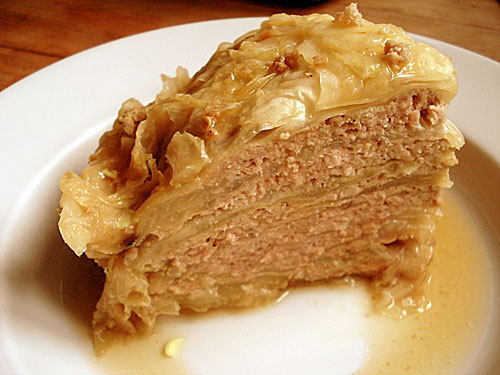
(From the archives. A perfect leave-to-cook, warming dish for a cold evening! Originally published December 2008.)
Some dishes dazzle you with their prettiness. Others may look plain, but are just plainly delicious. This simple, filling yet healthy winter dish of cabbage layered with a meat and tofu stuffing and then poached in a flavorful liquid belongs to the latter group.
Filed under:
winter yohshoku favorites meat cabbage slow cook
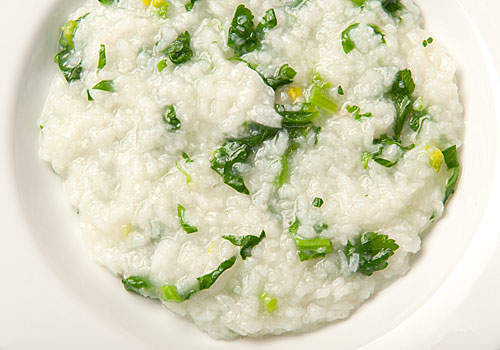
The more I study old Japanese customs, the more I am impressed by the logical thinking behind many of them, even when examined with modern eyes. One of these the custom of partaking of a bowl of nanakusagayu on the seventh day of the New Year, which supposedly started in the Heian Period (around the 12th century), in the refined court of Kyoto. Nanakusa means seven greens, and kayu (or to use the honorific term, okayu (お粥)), is rice porridge. The Imperial Court, now in Tokyo, still has a nanakusagayu ceremony on the morning of January 7th.
Filed under:
japanese lighter rice vegetarian vegan
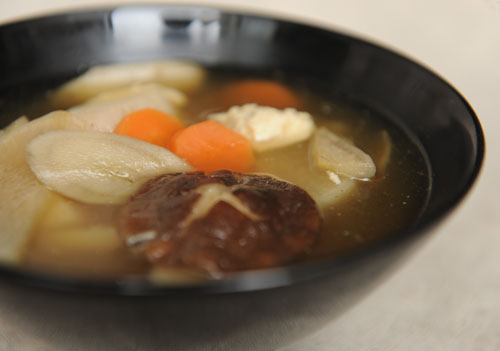
It's been a cold and snowy winter so far around these parts, which usually means soups and stews for dinner. This classic Japanese soup is hearty yet low in calories, full of fiber, and just all around good for you. It helps to counteract all the cookies and sweets you might be indulging in at this time of year.
The name kenchinjiru (けんちん汁)derives from the Zen Buddhist temple where it was first made (or so it's claimed), Kencho-ji (建長寺)in Kamakura. (Kamakura (鎌倉) was, for a brief while, the capital of Japan in the 12th and 13th centuries. Nowadays it's a major historical tourist attraction, and a fairly easy day trip from central Tokyo.) Since kenchinjiru is a shojin ryouri or temple cuisine dish, the basic version given here is vegan. It's still very filling because of all the high fiber vegetables used. You could make a very satisfying vegan meal just from this soup and some brown rice.
Filed under:
japanese lighter soup winter vegetarian favorites vegan washoku shojin
Originally published in December 2005, edited in November 2008.

Filed under:
drink winter christmas
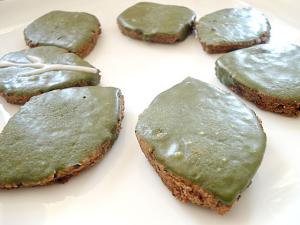
[From the archives. These sesame cookies with matcha icing look and taste quite dramatic. In leaf shapes they are rather spring-like, but try simple rounds or squares for year-round appeal. Originally published in April 2007.]
Flavor wise black sesame seeds aren't that different, if at all, from white or brown sesame seeds. But there is something about their dramatic black-to-grey color that is quite exciting. At the moment I'm quite enamored with black sesame seeds, and have been using them instead of the regular brown ones in everything from sauces to salads.
These leaf shaped cookies contain toasted and ground black sesame seeds, dark brown muscovado sugar, and whole wheat flour, and are decorated with matcha (powdered tea) royal icing. The sweetness is quite restrained, both in the cookie and in the icing. You are first hit by the tea-flavored, very slightly bitter icing, followed by the nutty darkness of the cookie. It's an intriguing combination. They are a wonderful accompaniment to tea, black or green, hot or iced. If the ultimate cookie to you means something very sweet and gooey you may not like these. They are quite adult cookies.
I had to shoot the pictures in a hurry, because they were disappearing faster than almost any other cookie I've made recently.
Since I don't have a leaf shaped cookie cutter, I just made a simple paper template and cut the leaves out with a knife. You can cut them out into any shape you'd like of course, though given the coloring leaves seem appropriate. Quite spring-like, in fact.
Filed under:
dessert japanese baking cookies favorites tea
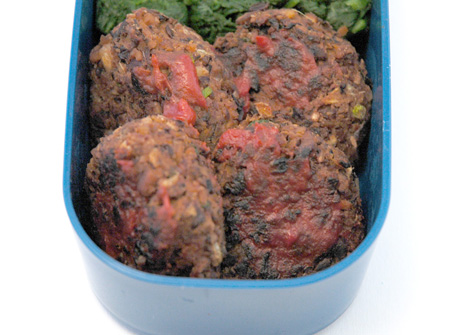
__From the archives. This is terrific freshy made and hot, but is even better cold, so it's great for bentos. Originally published in November 2007.__
Over the past couple of years as I've pursued
largely vegetarian eating, I've gradually accumulated a small arsenal of small, round bean patties or balls, which are great as snacks, for bento boxes, and just for dinner, in my regular rotation. This one was inspired by one of the first beany-round thing I made,
the samosa-like lentil snacks from
The Hungry Tiger, and a Japanese vegan cooking book called
_Saisai Gohan_ (Vegetable Meals) by Yumiko Kano. (Yumiko Kano is currently my favorite cookbook author in any language, and I'll talk more about her down the line.) I've adjusted a few things to make them gluten-free.
These have the earthy, deep flavor of the black beans that is enhanced by the spices and the sauce, and they are delicious hot or at room temperature. Even diehard carnivores like them. They're really perfect for bento lunches, and I've used it in the all-vegan
Bento no. 5 on Just Bento. I also used them as a pita-sandwich filling in
Bento no. 6.
I have described two methods of cooking these: in the oven, which is good for making them in quantity, and in a frying pan, which is perfect for making a few at a time.
Filed under:
japanese lighter legumes vegetarian vegan

I have not doing a lot of serious cooking lately, at least not the kind that results in a useful blog post. Most of my cooking energies have been expended on another project, which is wearing me down a bit (more on that at a later time). What I have been cooking for actual meals is very simple food, that requires minimal kitchen time, though not necessarily quick to cook.
The subject of this article is zucchini (courgette) slices that are slowly braised in a fragrant oil. It requires perhaps 10 minutes of actual kitchen time, but an hour or more to complete. Days even, if you choose one option. You don't need to hover over the pan for that time, but you do have to be nearby, to keep an eye on the hot oil, not to mention any errant pets, children or clumsy adults that wander in.
The wait and vigilance are worth it though. The zucchini slices, scented with the pine-mintiness of rosemary, become brown and sticky and almost caramelized on the surface, and soft and creamy on the inside. It's great as an accompaniment to roast or panfried meats or fish, or as part of a vegetarian meal (try it with pasta). I could have it every day, just on its own, if it weren't for the rather ruinous effect it has on my waistline, even if the oil is good-for-you olive oil.
This is the taste of late summer in Provence for me.
Filed under:
vegetarian provence summer vegan
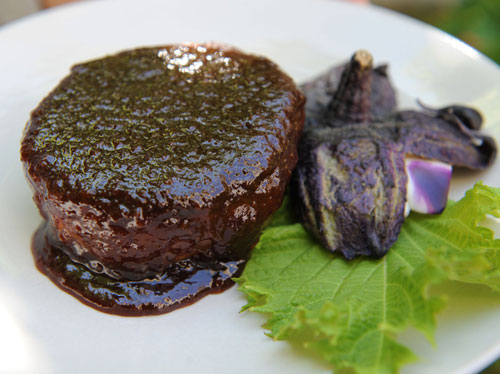
It's still summertime, but I can feel the cooler days of fall coming, especially in the evenings when the temperature is dropping just a bit more than it did a few weeks ago. This is one of the best times of the year for food lovers, especially if you love vegetables.
Eggplants (aubergines) are in high season now and will be around for at least another month or so. While you can get them year-round, they are at their best of course in their natural season.
This is a classic Japanese way of serving eggplant, and it's really easy. All you do is to slowly roast the eggplant until tender, either in the oven or on the stovetop in a frying pan, then serve with a glossy, salty-sweet dengaku (田楽)sauce. I could eat this every day, with a bowl of plain rice and some cold mugicha to wash it down.
Filed under:
japanese vegetables fall vegetarian summer vegan eggplant
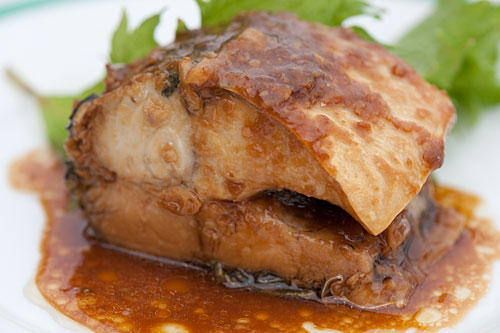
Here's another classic Japanese recipe from my mother. I have to admit that I'm not very good with fish, with the exception of simple grilling or panfrying and so on, but my mom has all kinds of great fish recipes up her sleeve.
Last week we spent a rather chilly week in Brittany (Bretagne), where the highlight was definitely the abundance of cheap, really fresh fish available to us. One fish in particular that was really good and inexpensive was maquereau, or Atlantic mackerel, which we know as saba (鯖 さば)in Japanese. In Japan, mackerel is usually treated one of three ways: grilled over an open flame (amiyaki), treated with salt and vinegar (shimesaba) and turned into an old fashioned kind of sushi (sabazushi), or gently braised in a sauce with the classic Japanese combination of salty-sweet flavors. This mackerel is cooked in a ginger scented miso sauce, then allowed to cool down in the liquid overnight, which allows the flavors to penetrate the firm flesh of the fish. You barely notice the oiliness at all, and the sauce is plate-lickingly tasty. I like to eat it chilled, right out of the refrigerator, with plain rice and a simple salad on the side. It makes for a refreshing yet rich dish for a summer meal.
Filed under:
japanese fish seafood
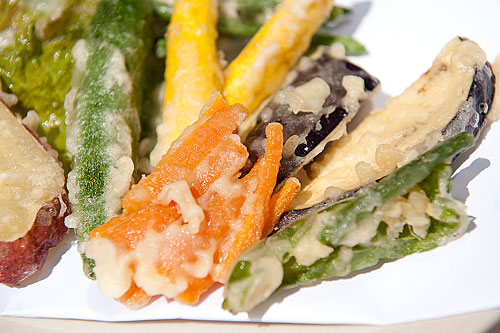
I've never really been good at making tempura, the quintessential Japanese deep fried dish. My mother's tempura has always been terrific - crispy, light, and not greasy at all. So, taking advantage of her extended vacation here this year, I drilled her properly on how she makes tempura.
Her method does not rely on special tempura flour (cheap in Japan but expensive or hard to get a hold of elsewhere), or other recently touted additions like vodka or other high-alcohol liquor, so anyone should be able to do it. Just follow the key points listed below.
Filed under:
japanese vegetables vegetarian washoku
Pages